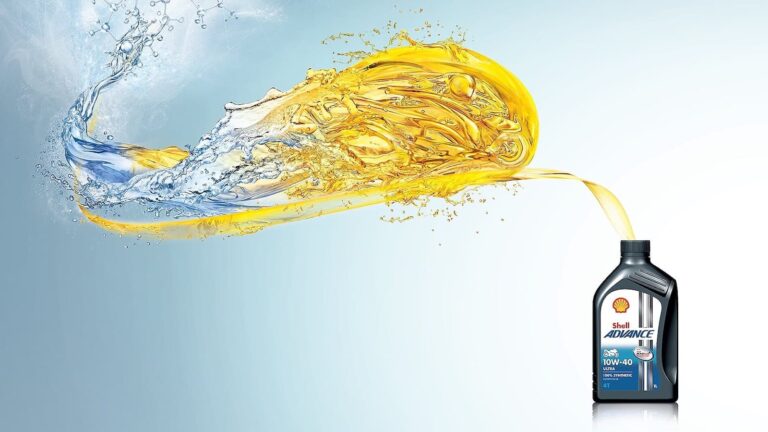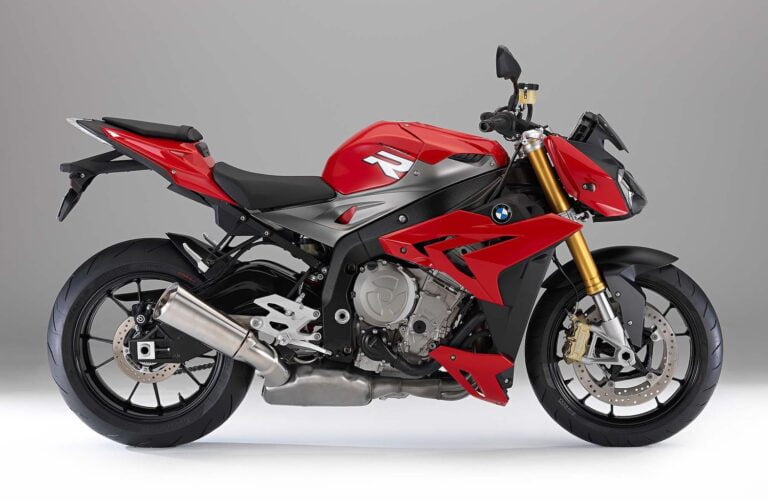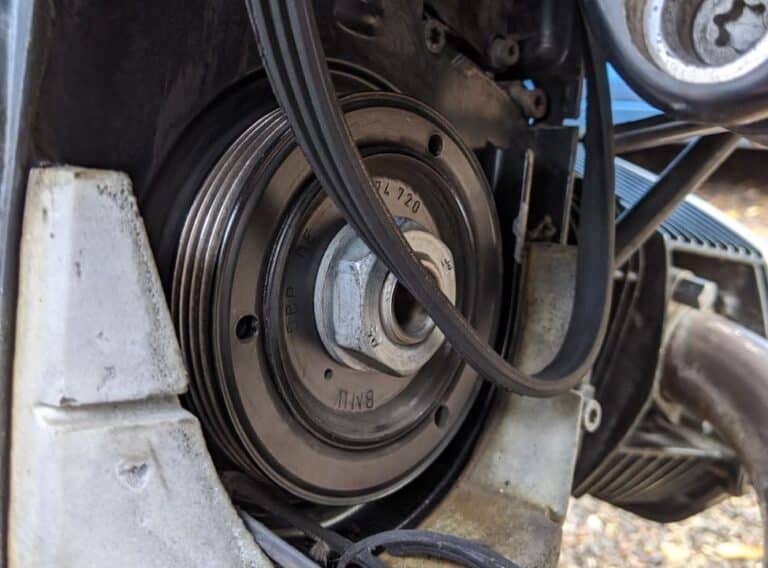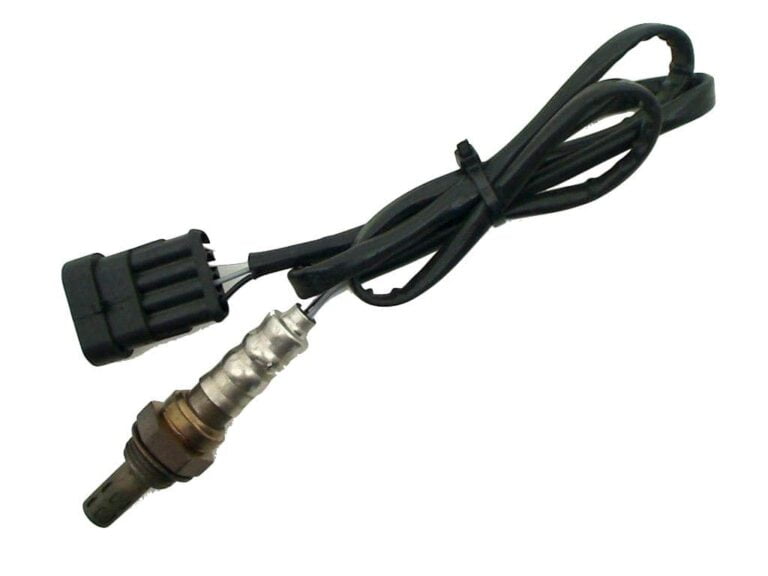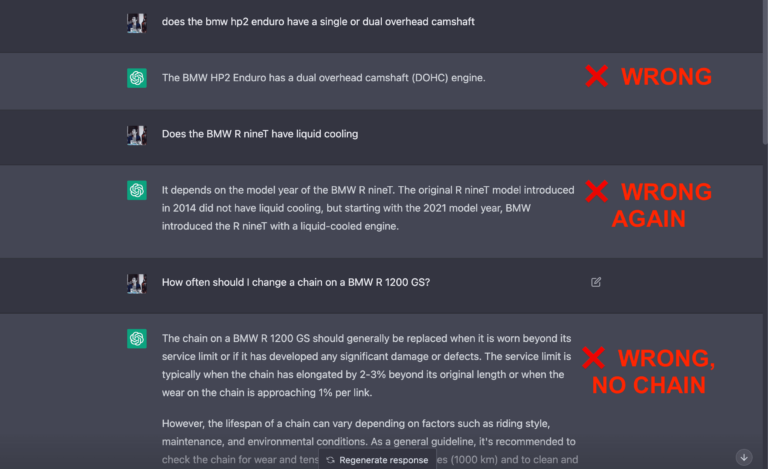Many manufacturers have experimented with alternative suspension styles, alternatives to the fork or inverted fork.
Most alternatives to the fork are niche pursuits, like the hub-centred steering setup on the Yamaha GTS1000, or the trailing link suspension on the Honda Valkyrie Rune, and don’t survive more than one model. There have been other attempts by smaller manufacturers on reduced scales, too.
But BMW’s Telelever front suspension setup has had years of successful usage, and its closely related sibling, Duolever, also was used on several models. Most recently, BMW has evolved Telelever into EVO Telelever, starting from the 2024 BMW R 1300 GS.
You might be curious to know what I was, every time I hear Telelever or Duolever mentioned:
- How does Telelever work, and what are its pros and cons?
- What’s Duolever, how is it related, and how does it work?
- How did Telelever evolve into EVO Telelever?
Plus any other interesting stuff that comes up, like a nod to the 2018+ 6th-gen Honda Gold Wing.
OK, here goes!
You might also like my article explaining BMW’s Paralever design, also known as CARC on Moto Guzzi motorcycles.
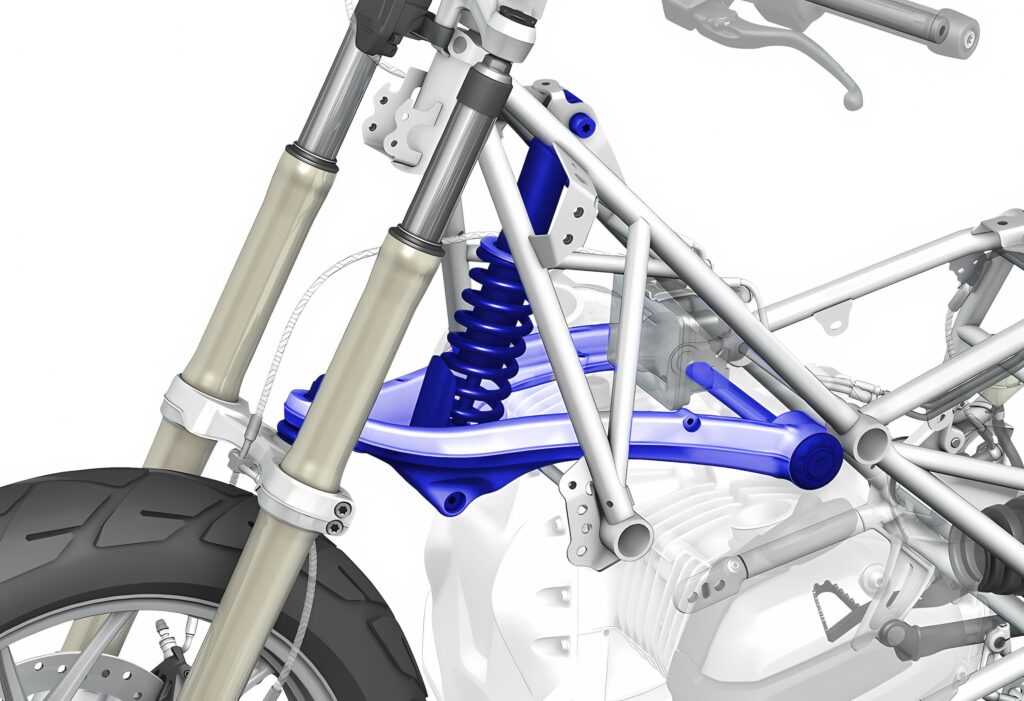
Are you obsessed with motorcycles?
Well, I am. That’s why I created this site — as an outlet. I love learning and sharing what others might find useful. If you like what you read here, and you’re a fraction as obsessed as I am, you might like to know when I’ve published more. (Check the latest for an idea of what you’ll see.)
How Telelever Suspension (R-bikes from the R 1100 RS onwards) works
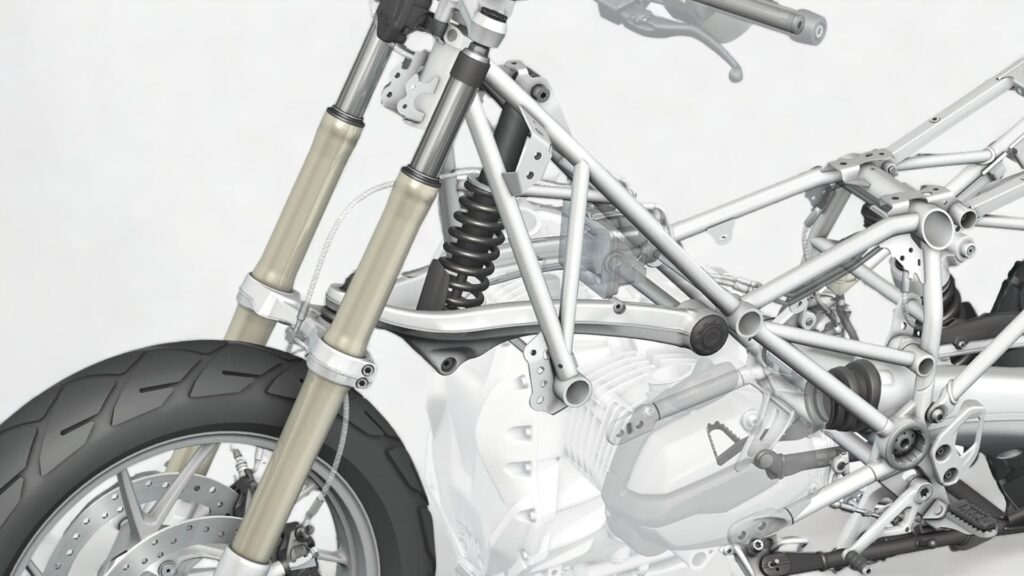
BMW first launched Telelever (*see note below) front suspension on the 1993 BMW R 1100 RS, and brought it to the R 100 GS shortly afterwards. BMW still Telelever on the R-bike line — but uses telescopic forks, too.
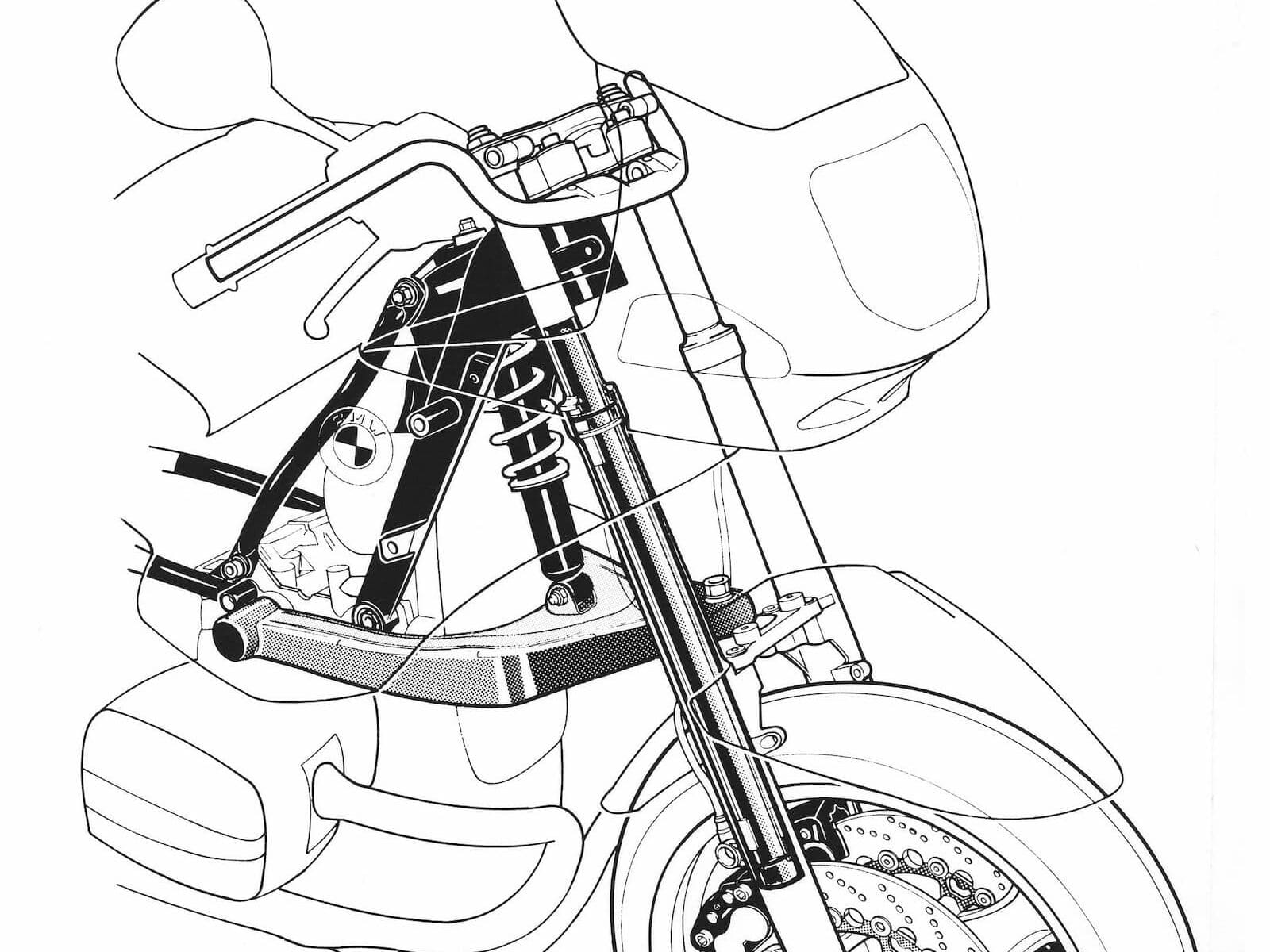
BMW replaced the front fork design from the earlier R 100 bikes with the Telelever design on the R 1100 motorcycles for a few reasons.
The first intention was to reduce fork compression under load, and the second was to reduce un-sprung mass. Finally, there were benefits relevant to the ABS systems of the time, but they are no longer relevant today.
Let’s look at how Telelever works. Telelever front suspension is of a wishbone design. It is made up of three primary components:
- Telescopic fork legs (like on other fork suspension)
- An A-arm (also known as a wishbone, or trailing arm)
- A central spring shock absorber/damper
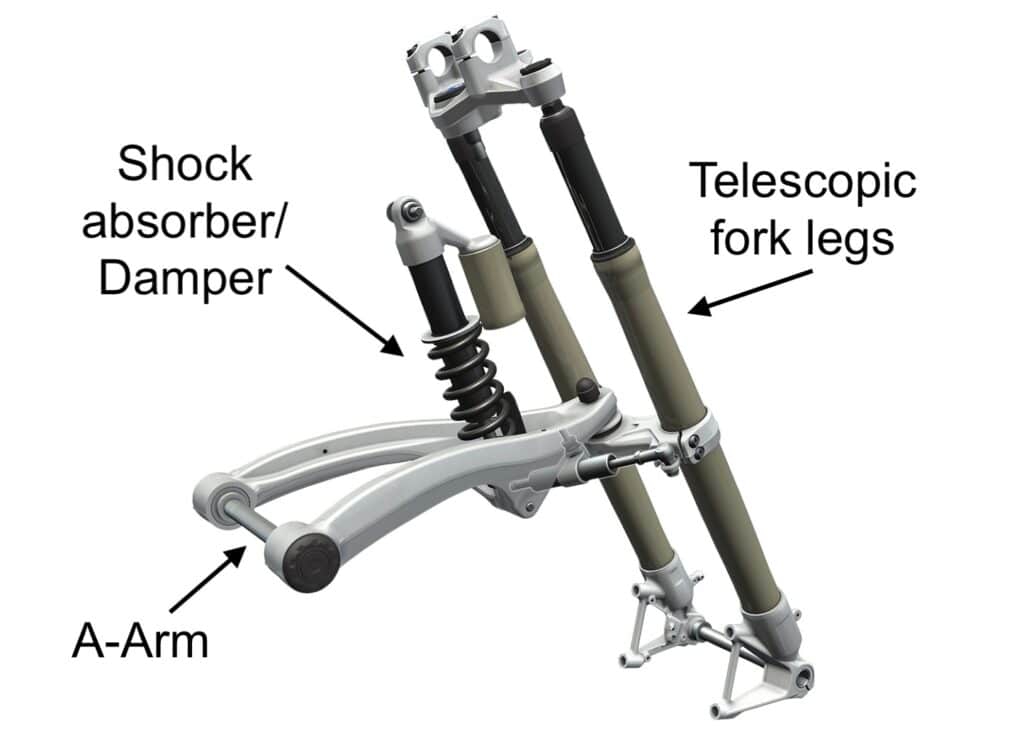
When the wheel moves up and down, the fork tubes compress and extend, like on a regular fork suspension setup. But they lever against the A-arm, which is attached to the chassis.
The part of the Telelever suspension setup that does all the shock absorption and damping is the shock absorber/damper attached to the A-arm.
You may notice that a Telelever setup still has regular forks and fork tubes. These don’t perform the same function as regular forks — they don’t have springs and damper units in them. They still absorb bumps, but their main job is to be able to slide without sticking. Thus, there’s oil in there, and a fork seal, but its only job is to lubricate, not to damp. (Nonetheless, the fork seal can leak, and you should attend to it if it does.)
There are a few advantages to the wishbone geometry. Firstly, the designers can “tune” it to cancel out fork dive to a significant degree, effectively eliminating it.
With conventional forks, the force on a wheel as it is braking pushes the tire backwards. This bends the fork backwards, and they compress. As the fork compresses, the handlebars move forward relative to the axle, and there is “dive” — this is the movement of the handlebars lower.
When the fork legs compress, the rake of a Telelever fork extends rather than compresses under load. So in practice, BMW motorcycles with Telelever suspension have very little dive, even under hard braking, which means that the riding experience is much more stable, without having to use fancy electronics like “Skyhook” suspension. Neat!
Secondly, in a Telelever suspension setup, there’s less unsprung mass.
You don’t have to have things like springs, heavy oil, and cartridges in the strut. This makes for better traction and more responsiveness However, there is more mass elsewhere, due to the A-arm.
Finally, since there’s just one shock absorber/damper, there was only one component that needed to be updated when tech updates came, like ESA or DDC (on later models). If you need to have it rebuilt or replaced, there’s just one, too.
Note: While BMW gets all the glory for Telelever, they weren’t the first company to use Telelever-style suspension in a motorcycle. That honour goes to the British company Saxon-Motodd, who used a similar setup on a few very niche bikes. However, BMW was the company to patent Telelever tech, and they’ve far and away been the one to most successfully commercialise it.
When BMW launched Telelever, there were other advantages related to the ABS systems of the time, but those are no longer relevant.
Cons of Telelever
Not everyone is a fan of the Telelever system. Some don’t like the lack of dive, feeling like it removes front-end feeling. It takes getting used to, especially on a sport motorcycle where you may be accustomed to braking intensely, and thus expect dive.
Dive also helps with motorcycle handling in some situations. Motocross and track riders know this best. On motorcycles with telescopic forks, fork dive reduces the rake and trail of the motorcycle, which helps the rider turn more easily. This is a fundamental element of trail braking.
So it should come as no surprise that during testing, BMW reportedly realised that motorcyclists expected a bit of dive, and thus engineered some in. In theory, the Telelever geometry can be arranged to effectively eliminate dive from the suspension, but that would be net negative.
Another complication of BMW’s implementation of Telelever is that the wishbone goes exactly where the radiator goes on liquid-cooled bikes. This wasn’t initially a problem — BMW instituted Telelever around two and a half decades before their first liquid-cooled boxers. When BMW released first “Wetheads”, they implemented two radiators located on the sides.
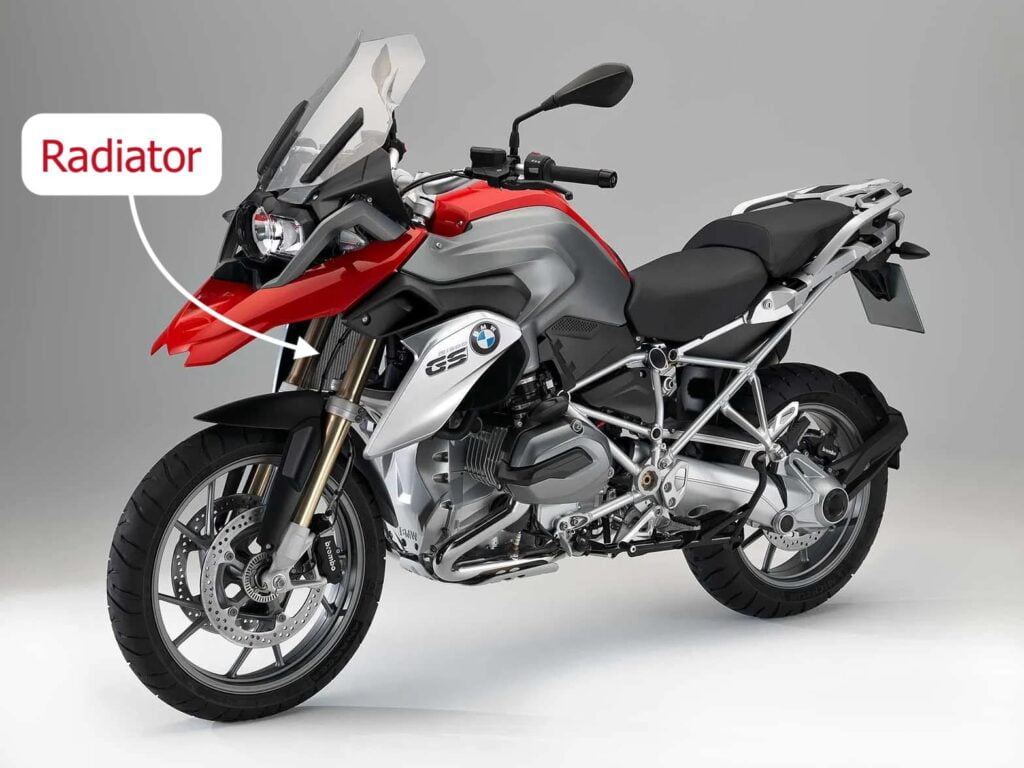
That works, but it means more hoses and more radiators, and a concern that the radiators might be damaged if the bike is dropped. That hasn’t been a gripe with riders, though.
BMW themselves don’t use Telelever everywhere, and have reduced the motorcycles on which they use it. They used to use it on their sport bikes, but that ended with the BMW HP2 Sport — the S 1000 RR series went back to inverted telescopic forks.
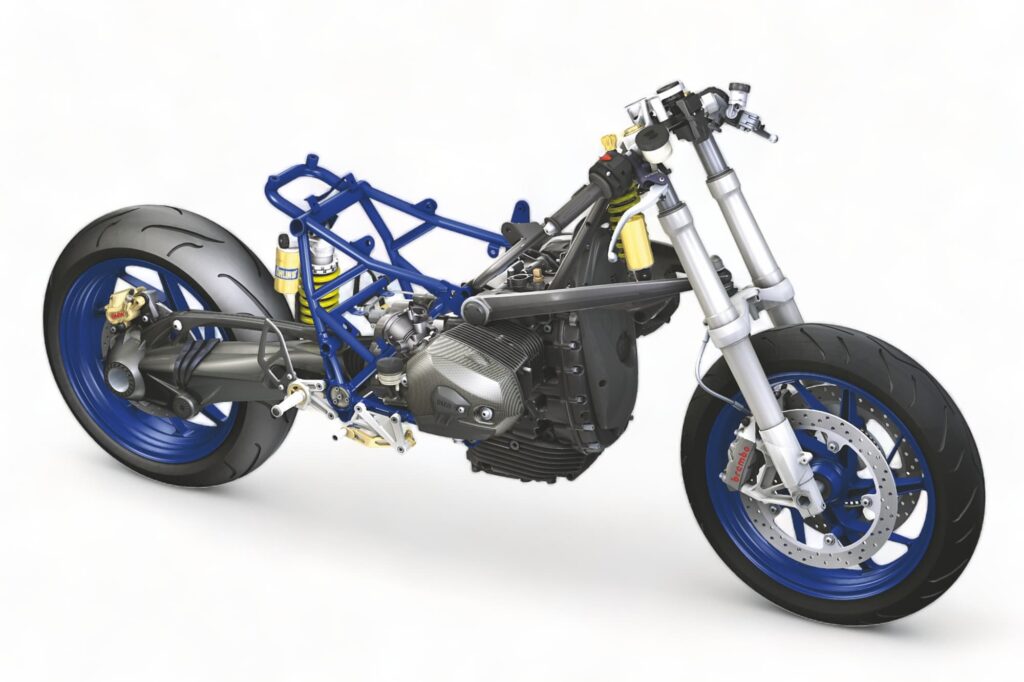
BMW also stopped using Telelever in their sportier boxer road bikes, like the R 1200 R from the liquid-cooled generation starting in 2015, or its fairing-equipped sibling, the R 1200 RS. The whole BMW R nineT series also uses conventional forks.
However, BMW still uses Telelever in their adventure touring and touring motorcycles, including the BMW R 1300 GS — though that has evolved to an advanced design called “EVO Telelever” (discussed below).
Duolever Suspension (K 1200 S and subsequent K-bikes)
BMW released a new front-end suspension design, Duolever, for the high-speed sport tourer the BMW K 1200 S, and kept it in subsequent bikes in the family, including the K 1300 and the K 1600 ranges.
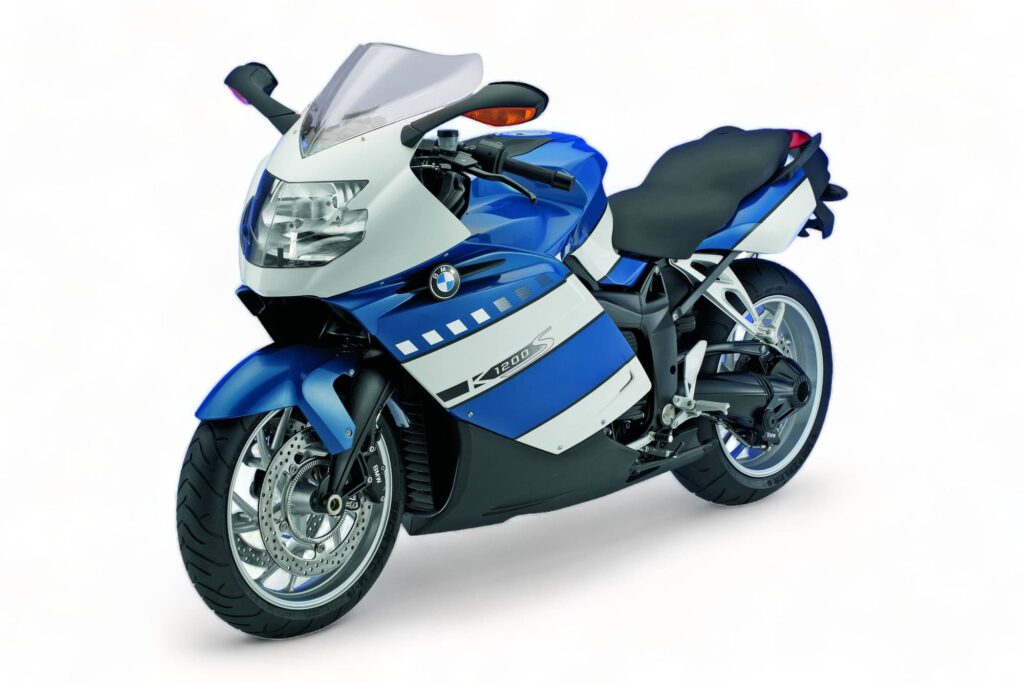
Firstly, it’s impossible to discuss Duolever (or Honda’s implementation) without talking about its inventor — Norman Hossack, a prodigious Scottish inventor. Duolever was originally called “Hossack” suspension, and he was using them on motorcycles as early as the 80s — and winning races with them. Modern implementations are all based on his patents.
Because Duolever-style or Hossack suspension is used on select few other motorcycles, all references below using one name apply to the others.
Duolever has the same fundamental principle as Telelever suspension — it uses trailing arms and a central strut, and its aim is to decouple steering and suspension.
But the main differences between Duolever and Telelever are:
- There are two trailing arms (thus the name “Duo” lever) — the upper and lower,
- The arms are semi-trailing arms — they trail behind the wheel, between the front axle and the chassis, and
- There’s no fork at all!
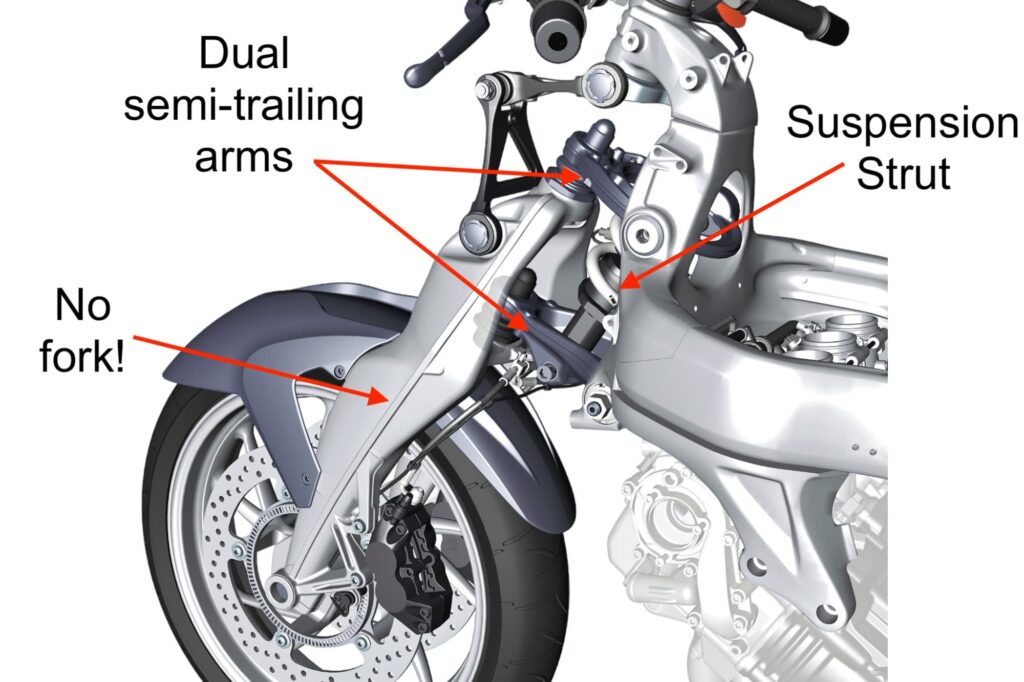
The fact that the Duolever/Hossack-equipped bikes don’t have a telescopic fork makes me double-take every time I look at them. It made me appreciate the fact that we call it a “telescopic” fork on most motorcycles — but this is still a “fork”.
The intention of Duolever is, as with Telelever, to prevent geometry changes when the suspension moves under compression. BMW describes this as “separating the functions of steering and damping”, which is similar language to how they describe EVO Telelever (below).
The trapezoidal structure of the Duolever/Hossack setup means that when the wheel goes up due to a bump, it absorbs the shock without diving as much as a conventional fork would. The semi-trailing arms act as levers and reduce the dive effect.
The main benefit of Duolever suspension is much greater rigidity in the suspension. In conventional forks, when choosing the appropriate fork diameter, there’s always a trade-off between rigidity and mass. With Duolever suspension, by contrast, the solid-piece forks are much more rigid by default, as they don’t have moving parts.
The implementation of Duolever/Hossack is such that during braking, there is almost no dive. There is still reaction to surface imperfections, and you can feel them, but they’re more muted, too.
Secondarily, when cornering, forks compress unevenly, which can magnify any imbalances present. While not a major problem for most riders, having one central strut eliminates it nonetheless.
The perceived cons of Duolever are similar to those of Telelever. There’s less road feel, and the lack of dive can be disconcerting. However, less dive doesn’t mean there’s less traction. Many riders say they adjust to the way Duolever performs quickly and can corner with confidence.
Futher, Duolever is heavier than Telelever or a conventional fork. In luxury high-speed tourers like the K bikes, this isn’t a significant matter, but it is a significant problem in a sport bike like the S-series, where every pound / kg counts.
These days, the only BMW motorcycle in production with Duolever suspension is the K 1600 GT touring bike, which BMW has been making since 2011. But its direct competitor, 2018+ 6th gen Honda Gold Wing, uses a suspension type that might look a little familiar.
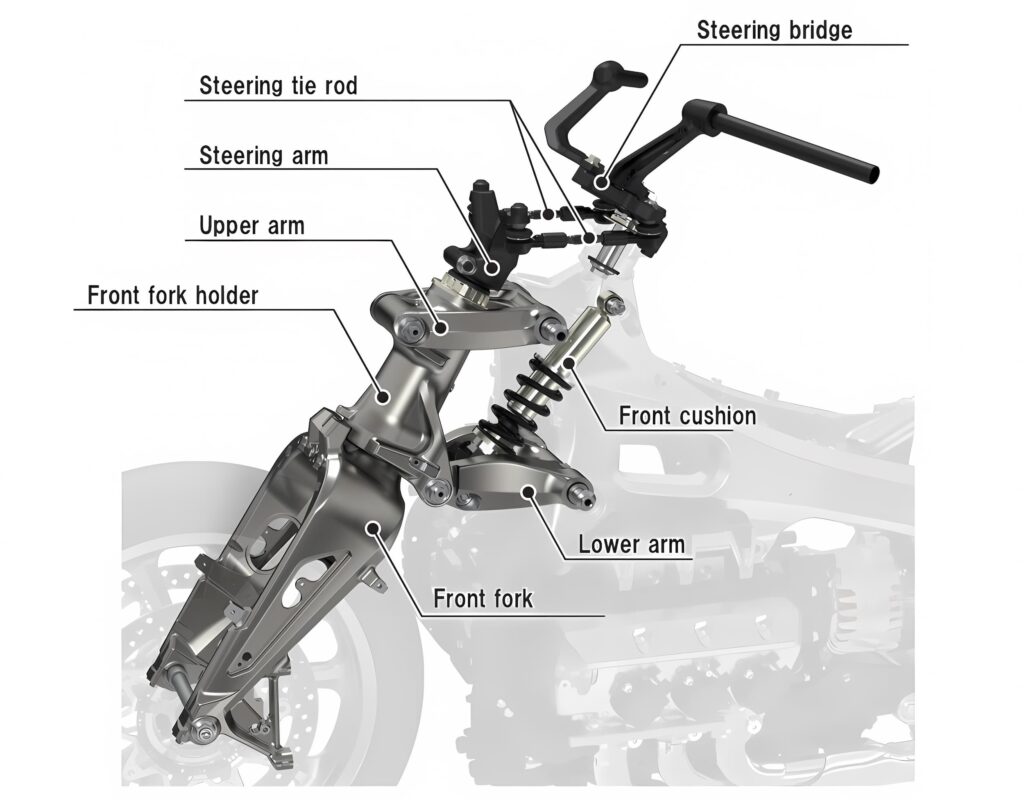
Honda just calls it “double wishbone front suspension”. But it’s the same Hossack suspension setup used in BMW K-bikes. The principle of Honda’s double wishbone front suspension is the same — allowing the wheel to move much more vertically rather than directly backwards.
Honda said that in the 6th gen Gold Wing (the 5th gen had a conventional telescopic fork), this allowed them to keep the weight of the engine forwards, which helps with overall balance, and to keep the handlebars closer to the rider while providing a rigid steering connection, which increases comfort. Both are wins!
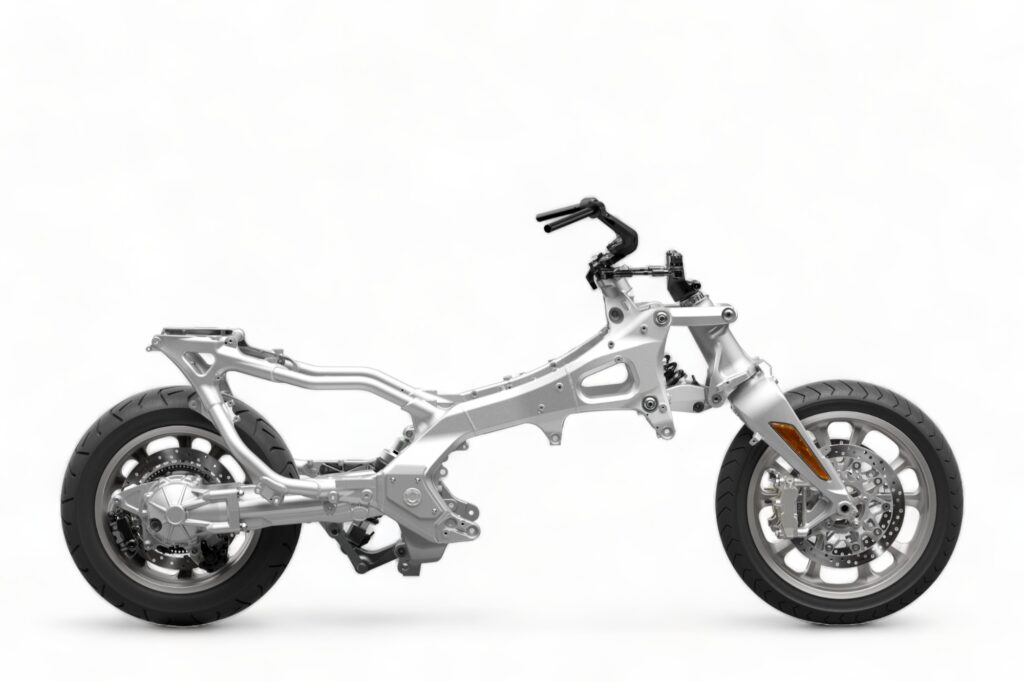
EVO Telelever (2024 BMW R 1300 GS onward)
For the BMW R 1300 GS released in 2023 for the 2024 model year, BMW iterated again on Telelever, releasing EVO Telelever, among other things.
See here for the complete guide to the BMW GS range, showing changes since the first R80 G/S.
BMW introduced “EVO Telelever” at the front end, which decouples the handlebar from the fork, transmitting steering forces but disassociating tilting, improving the sense of stability under braking or acceleration.
On a regular fork, regular Telelever, or any suspension with dive, as the handlebars dives forwards under breaking or bumps, the handlebars also rotate forwards. The EVO Telelever is designed to eliminate this rotation of the handlebars.
The EVO Telelever system’s design concept is similar to how BMW has addressed suspension design in the rest of its Telelever / Paralever system: decoupling unwanted effects through bearings, swivels, and pivots, while transmitting others that you need (in this case, steering).
So, how does EVO Telelever work? A high-level summary is that through a system of bearings and connectors, centred around a flexible stainless steel plate, BMW has decoupled the tilting motion while transmitting the steering motion with even greater precision than before.
The “flexible plate” is the arc-shaped plate that you see bolted to the top of the fork bridge. BMW calls it a “flex element”.
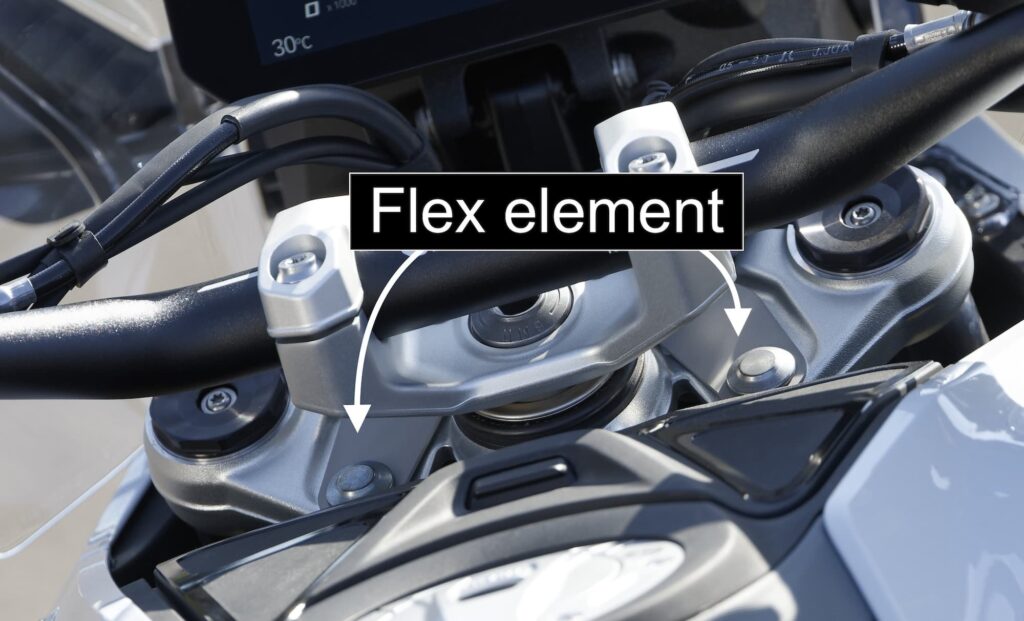
Its geometric design transmits steering forces, while compensating for tilting.
But “flexible”? That sounds like it’ll wear out. High school physics told me that if you flex metal of any kind many times, it eventually snaps. And indeed, the flexible plate does need maintenance — checking its integrity is part of the new R 1300 GS’ maintenance schedule. But generally, I would presume its composition to be something like that of a suspension spring — designed to be flexed an extreme number of times.
There’s more to the EVO Telelever system, of course. A radial swivel bearing connects the upper fork bridge to the steering shaft tube, which is held in the main frame via two bearings at the top and bottom.
BMW says the EVO Telelever design is particularly important on motorcycles with wide handlebars and long suspension travel, which means it may not make it to the sportier variants of the R 1300 line (e.g. an R 1300 RS or RT) — when they’re released.
Wrap Up — Are Telescopic Forks Bad?
The vast majority of my riding has been on motorcycles with telescopic forks. And never have I thought “Gosh, this is terrible.”
There are lots of things to be said in favour of telescopic forks. They’re light. They work fine or most people, under non-extreme situations. And they’re replaceable — so if I destroy the fork on my bike, I could find a fork from a similar motorcycle and shoehorn them in, assuming diameters and lengths match up.
In fact, I’ve thoroughly enjoyed motorcycles with conventional (“right-side-up”) telescopic forks, which have their own benefits — when they blow a fork seal, they don’t lose all their fluid, for example.
In addition, there’s the usual “function” vs “character” argument to bear in mind. Some people ride hardtail Harleys because they can. Some people want motorcycles to be a bumpy, jarring experience, because it is nostalgic or reminds them that they’re alive, or whatever. Motorcycles are a personal experience.
So, while there are definite comfort and function advantages to all of the above, and many swear by them, there’s definitely no final answer on what’s best for you. It’s just cool tech that shows just what is possible on high-end machines.
Hopefully the above info will be just things to consider when shopping for your next bike.

